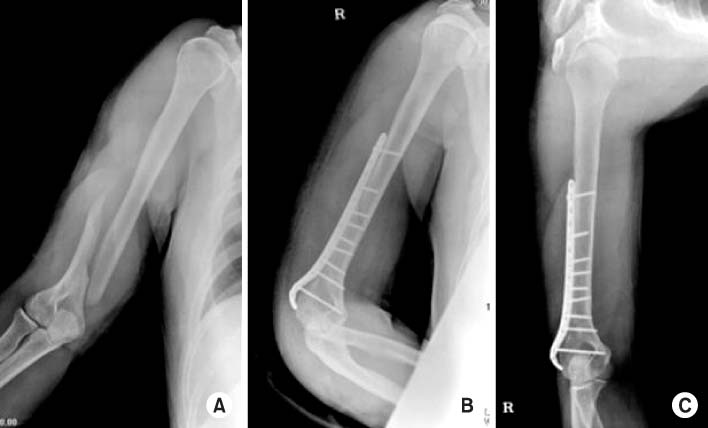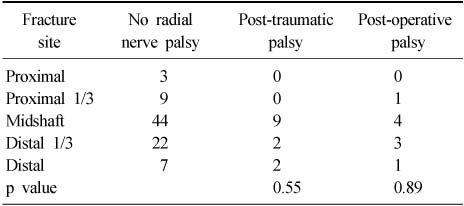Articles
- Page Path
- HOME > J Musculoskelet Trauma > Volume 21(4); 2008 > Article
-
Original Article
- Contributing Factors of Radial Nerve Palsy Associated with Humeral Shaft Fracture
- Tae-Soo Park, M.D., Joon-Hwan Lee, M.D., Tai-Seung Kim, M.D., Kwang-Hyun Lee, M.D., Ki-Chul Park, M.D.
-
Journal of the Korean Fracture Society 2008;21(4):292-296.
DOI: https://doi.org/10.12671/jkfs.2008.21.4.292
Published online: October 31, 2008
Department of Orthopaedic Surgery, Guri Hospital, Hanyang University College of Medicine, Guri, Korea.
*Department of Orthopaedic Surgery, Hanyang University College of Medicine, Seoul, Korea.
- Address reprint requests to: Ki-Chul Park, M.D. Department of Orthopaedic Surgery, Guri Hospital, Hanyang University College of Medicine, 249-1, Gyomun-dong, Guri 471-701, Korea. Tel: 82-31-560-2316, Fax: 82-31-557-8781, kcpark@hanyang.ac.kr
Copyright © 2008 The Korean Fracture Society. All rights reserved.
This is an Open Access article distributed under the terms of the Creative Commons Attribution Non-Commercial License (http://creativecommons.org/licenses/by-nc/3.0/) which permits unrestricted non-commercial use, distribution, and reproduction in any medium, provided the original work is properly cited.
- 525 Views
- 0 Download
- 3 Crossref
Abstract
-
Purpose
- To analyze related factors of radial nerve palsy in patients with humeral shaft fractures.
-
Materials and Methods
- We reviewed 107 paients with humeral shaft fracture between January 2000 and June 2007. Thirteen patients had radial nerve palsy after trauma and 9 patients after the operation. We analyzed contributing factors of radial nerve palsy associated with humeral shaft fracture including the cause of trauma, location and pattern of fracture, surgical approach and tourniquet application in cases of plate fixation, the exploration for the nerve and the time for operation.
-
Results
- The difference in the incidences of radial nerve palsy after trauma and operation was not significant according to the location and pattern of fracture. The tendency of higher rate of radial nerve palsy after trauma in oblique or comminuted fractures, and after operation in spiral fractures was observed. The operation using intramedullary nailing and radial nerve exploration significantly reduced the incidence of radial nerve palsy after operation (p=0.01 and p=0.02). Posterior approach in open reduction and plate fixation showed a tendency of lower incidence of radial nerve palsy after operation (p=0.78). In logistic regression analysis, radial nerve exploration was the only significant factor that reduced the possibility of radial nerve palsy after operation (17.27: odds ratio, p=0.02).
-
Conclusion
- In humeral shaft fractures, we should take into consideration whether intramedullary nailing is possible or not. In cases of anterior or anterolateral approach of open reduction and plate fixation, radial nerve should be carefully inspected. In most cases, we recommend radial nerve exploration in order to minimize the possibility of radial nerve palsy after operation.
- 1. Blum J, Rommens PM. Surgical approaches to the humeral shaft. Acta Chir Belg, 1997;97:237-243.
- 2. Duncan DM, Johnson KA, Monkman GR. Fracture of the humerus and radial nerve palsy. Minn Med, 1974;57:659-662.
- 3. Garcia A Jr, Maeck BH. Radial nerve injuries in fractures of the shaft of the humerus. Am J Surg, 1960;99:625-627.
- 4. Holstein A, Lewis GM. Fractures of the humerus with radial-nerve paralysis. J Bone Joint Surg Am, 1963;45:1382-1388.Article
- 5. Kesemenli CC, Subasi M, Arslan H, Necmioglu S, Kapukaya A. Comparison between the results of intramedullary nailing and compression plate fixation in the treatment of humerus fractures. Acta Orthop Traumatol Turc, 2003;37:120-125.
- 6. Kettelkamp DB, Alexander H. Clinical review of radial nerve injury. J Trauma, 1967;7:424-432.Article
- 7. Kim DH, Shin KC, Kim KS, Lee SH. Ender nailing of humeral shaft fractures. J Korean Soc Fract, 1997;10:614-620.Article
- 8. Klenerman L. Fractures of the shaft of the humerus. J Bone Joint Surg Br, 1966;48-B:105-111.ArticlePDF
- 9. Ko SM, Kim MG, Kim RS, Oh IS, Lee JY, Jeong HC. Treatment of humerus fracture using ilizarov external fixator. J Korean Soc Fract, 2000;13:30-37.Article
- 10. Lin J. Treatment of humeral shaft fractures with humeral locked nail and comparison with plate fixation. J Trauma, 1998;44:859-864.Article
- 11. Pollock FH, Drake D, Bovill EG, Day L, Trafton PG. Treatment of radial neuropathy associated with fractures of the humerus. J Bone and Joint Surg Am, 1981;63:239-243.
- 12. Shah JJ, Bhatti NA. Radial nerve paralysis associated with fractures of the humerus. A review of 62 cases. Clin Orthop Relat Res, 1983;172:171-176.
- 13. Shao YC, Harwood P, Grotz MR, Limb D, Giannoudis PV. Radial nerve palsy associated with fractures of the shaft of the humerus: a systemic review. J Bone Joint Surg Br, 2005;87:1647-1652.
- 14. Shaw JL, Sakellarides H. Radial-nerve paralysis associated with fractures of the humerus. A review of forty-five cases. J Bone Joint Surg Am, 1967;49:899-902.
REFERENCES
(A) Pre-operative, (B) post-operative and (C) final anteroposterior radiographs of a spiral distal humeral shaft fracture in a 30-year-old man following operative treatment with open reduction and plate fixation was shown. The radial nerve palsy developed after the operation and recovered in 6 weeks after the operation.

Fracture site and post-traumatic or post-operative radial nerve palsy

Fisher's exact test, Proximal: from surgical neck to the proximal 1/3 portion of diaphysis, Proximal 1/3: junctional portion between proximal segment and midshaft, Midshaft: from the proximal 1/3 to the proximal 2/3 portion of diaphysis, Distal 1/3: junctional portion between midshaft and distal segment, Distal: from the proximal 2/3 portion of diaphysis to just above medial and lateral epicondyle.
Figure & Data
REFERENCES
Citations

- Treatment of Radial Nerve Palsy Associated with Humeral Shaft Fracture
Soo-Hong Han, Jin-Woo Cho, Han-Seung Ryu
Archives of Hand and Microsurgery.2020; 25(1): 60. CrossRef - Associated Factors of Radial Nerve Palsy Combined with Humerus Shaft Fracture
Si-Wuk Lee, Chul-Hyun Cho, Ki-Choer Bae
Journal of the Korean Fracture Society.2014; 27(3): 185. CrossRef - Polarus Intramedullary Nail for Proximal Humeral and Humeral Shaft Fractures in Elderly Patients with Osteoporosis
Youn-Soo Hwang, Kwang-Yeol Kim, Hyung-Chun Kim, Su-Han Ahn, Dong-Eun Lee
Journal of the Korean Fracture Society.2013; 26(1): 14. CrossRef

Fig. 1
Fracture site and post-traumatic or post-operative radial nerve palsy
Fisher's exact test, Proximal: from surgical neck to the proximal 1/3 portion of diaphysis, Proximal 1/3: junctional portion between proximal segment and midshaft, Midshaft: from the proximal 1/3 to the proximal 2/3 portion of diaphysis, Distal 1/3: junctional portion between midshaft and distal segment, Distal: from the proximal 2/3 portion of diaphysis to just above medial and lateral epicondyle.
Fracture type and post-traumatic or post-operative radial nerve palsy
Fisher's exact test.
Surgical approach and post-operative radial nerve palsy performed at author's hospital
Fisher's exact test.
Fisher's exact test, Proximal: from surgical neck to the proximal 1/3 portion of diaphysis, Proximal 1/3: junctional portion between proximal segment and midshaft, Midshaft: from the proximal 1/3 to the proximal 2/3 portion of diaphysis, Distal 1/3: junctional portion between midshaft and distal segment, Distal: from the proximal 2/3 portion of diaphysis to just above medial and lateral epicondyle.
Fisher's exact test.
Fisher's exact test.

 E-submission
E-submission KOTA
KOTA TOTA
TOTA TOTS
TOTS


 Cite
Cite

